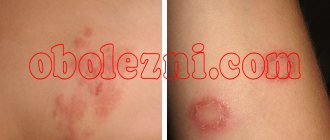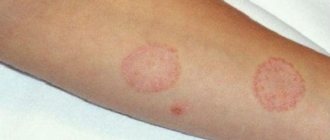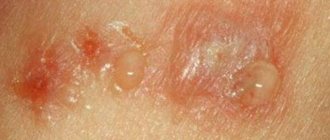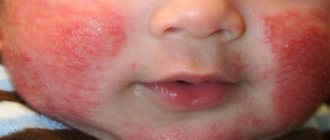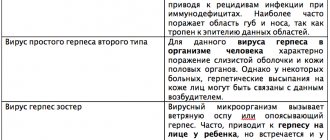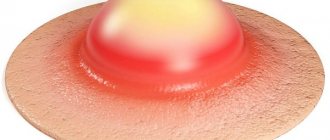Pityriasis rosea is a skin pathology, the causes of which are not fully understood. It is believed that it develops under the influence of a virus. The pathogen penetrates the body and is activated when there are problems with the immune system. This skin disease should not be ignored, because in the absence of treatment, other infections may occur. You can find out how to quickly cure pityriasis rosea in a person at home from a dermatologist.
Signs of lichen
The ointment suppresses the growth and development of vital functions of parasites that have viral and fungal forms. These drugs have a targeted effect and relieve skin flaking, itching and redness.
Along with them, compounds containing sulfur and tar are actively used in treatment. Solutions of salicylic acid are often used. What ointments are considered the best for treating various types of lichen?
Treatment of pityriasis rosea
The type of lichen is considered not contagious. It flows easily. Do not resort to intensive care during treatment. Some experts believe it may be caused by an infection. Heals quickly. Therapy is aimed at relieving symptoms. The use of various emulsions with sulfur and salicylic acid is indicated.
What components are present in ointments for the treatment of lichen?
Sulfur-tar ointment. Removes all signs of the disease. Active components dry the surface and promote healing. The course of treatment depends on the degree of the disease and lasts up to two weeks.
Sulfur-salicylic ointment. Kills the source and promotes healing. The course is carried out for ten days.
Oletterin ointment is often used in the diagnosis of this species. Gives excellent results in the fight against bacteria.
For particularly severe forms and to prevent re-development, ointments containing steroid hormones are used. Sinaflar, Flucinar extinguish lesions and quickly heal the skin. But professionals recommend using such medications rarely.
Description of the drug
Zinc ointment is an effective drug for the treatment of infectious and inflammatory skin diseases.
It is a thick, fatty substance that is white or slightly yellowish in color. The drug emits a specific “medical” smell of Vaseline. The drug has many advantages over other drugs for local application:
- possibility of use during pregnancy and lactation;
- the ingredients are able to accumulate in all layers of the epidermis, which provides a long-lasting clinical effect;
- low cost - from 30 to 40 rubles per package, depending on the manufacturer;
- after discontinuation of the drug, there is no exacerbation of symptoms, as with glucocorticosteroids;
- a small number of contraindications;
- low likelihood of developing local adverse reactions.
In most cases, zinc ointment is used as an adjuvant in the treatment of lichen. It enhances and prolongs the clinical effect of antiviral and antimycotic agents. The use of an antiseptic can significantly reduce the duration of therapy and speed up a person’s recovery.
Clinical and pharmacological group
Zinc ointment is part of a group of drugs with dermatoprotective activity. It manifests itself due to a multifaceted positive effect on the affected tissue. The medicine sanitizes infectious foci, cleanses them of bacteria, viruses and fungi. This leads to relief of the inflammatory process and weakening of symptoms.
pharmachologic effect
Zinc ointment is good at sanitizing tissues damaged by inflammation. Under the influence of the active ingredient, toxic compounds are removed from them. These include products of cell decay and the vital activity of microbes, viruses, and fungi. As a result, metabolism is accelerated, blood circulation and microcirculation are optimized. The tissues are saturated with nutritional and biologically active compounds - vitamins, microelements.
Cells begin to regenerate, which is visualized by healing of wounds and discoloration of spots.
Doctors recommend the use of Zinc ointment because of its complex effect on the skin of adults and children:
- the main ingredient (zinc oxide) exhibits pronounced adsorbing activity. It absorbs excess fluid that accumulates in the area of edema. Zinc oxide also attracts and binds the final and intermediate products of the inflammatory process on its surface;
- the active substance coagulates (folds) proteins located on the surface of infectious foci. This not only prevents infection, but also stops inflammation;
- zinc oxide reduces the activity of infectious pathogens, prevents their growth and reproduction in human skin;
- the chemical compound inhibits the biosynthesis of prostaglandins - mediators of pain, swelling and inflammation.
The auxiliary ingredient of Zinc ointment is Vaseline. It is not only used to form an ointment base. Vaseline counterbalances the strong drying effect of zinc oxide. The auxiliary component retains much-needed moisture in the skin and prevents its evaporation.
Release form and composition
At the pharmacy you can buy Zinc ointment, packaged in aluminum tubes or dark glass jars of 25 and 30 g. Its composition is very simple - zinc oxide and medical petroleum jelly.
Some manufacturers add other active ingredients to the drug. But dermatologists recommend using only the classic version of the remedy to treat lichen. Salicylic-zinc paste is also used in the treatment of this pathology. Due to the presence of salicylic acid in the composition, it has a keratolytic effect. After applying Salicylic-zinc paste, the keratinized scales are quickly exfoliated.
Ointments for the treatment of herpes zoster
Infects with a virus that is classified as herpes. Many drugs contain the active substance anciclovir, which copes well with this infection. Attributed to Antsigerpin, Zovirax, Vivorax, Herperax.
The ointments are applied for a long time up to six times a day. Procedures are carried out regularly. In severe forms of lichen, ointments containing hormones are prescribed.
The virus has a tendency to spread; safety precautions are being followed. Use gloves.
Ibuprofen, Ketoprofen. These ointments are prescribed for severe neuralgic pain; they relieve pain well.
Gel Panavir. Has an antiviral effect.
- Photos of lichen - main types, description of the disease, signs and modern methods of treatment
Ringworm in humans - types, symptoms and description of the disease. Signs, distribution and treatment (105 photos)
Lichen versicolor: 95 photos, treatment regimens, symptoms and signs of the disease. Tips from dermatologists for skin restoration
Tips and tricks
Treatment of pityriasis rosea with folk remedies is effective. But during self-treatment, you should not scratch the “plaques”, otherwise this can lead to the introduction of a bacterial infection.
If an infection is added to the disease, then therapy with folk remedies will no longer be effective, in which case drug antibacterial therapy will be required.
For the fastest treatment of pityriasis rosea, it is recommended to observe the following:
- During the period of therapy, you should avoid visiting baths, saunas, baths, and showers. Rubbing the body with warm water is used as body hygiene. Do not wet the “plaques” with water, soap or shower gel;
- It is not recommended to use cosmetic body creams. During the treatment period, it is important to avoid visiting massage rooms, beauty salons, swimming pools, and solariums;
- It is good for the body to wear clothes only made from natural fabrics. This advice should be followed both during and after therapy;
- You should organize the right menu, which will not contain allergenic products. Dairy, salty, canned, pickled, and spicy foods are removed from the patient’s diet. It is prohibited to drink carbonated drinks and alcohol. You should limit your consumption of sweet foods and sea fish.
In the room where the patient lives, the following procedures should be carried out daily:
- ventilation;
- quartzing;
- wet cleaning.
Pityriasis rosea can be smeared with iodine only at the initial stage of the disease. On the recommendation of a specialist, the main methods of treating pityriasis rosea are determined.
Ointments for lichen planus
The disease occurs in a severe form with exacerbations. Ointments are used based on tar. Infected areas are lubricated with sea buckthorn oil. Hormones are used.
Advantan. Often prescribed for therapy. It has an antihistamine effect, relieves itching, relieves swelling, and heals well. Apply once daily.
Celestoderm. Contains the active hormone betamethasone. Relieves allergies, irritation, heals the skin with frequent daily use (up to six times).
Analogues of these drugs include hydrocortisone and prednisolone, Flumethasone, Triamcinolone.
They are classified as hormonal drugs, so they are used for a short time during therapy.
It is necessary to strictly follow the instructions for using ointments for lichen.
How to choose a drug
The most important principles in the matter of choice are safety and effectiveness. To avoid harm to your baby, consult a doctor when you notice the first signs of illness. Having found out the nature of the disease, the pediatrician will prescribe antiviral or antifungal ointments for children against lichen. They must be used according to the instructions, observing the doctor for changes in the dynamics of improvement.
During treatment, the child should be prohibited from scratching and touching the stains, pay attention to personal hygiene, and disinfect clothes and household toys. To boost immunity, which is one of the reasons for the spread of the disease, you need to walk more, be in the fresh air, review your diet, and take healing baths. You should not use hormonal ointments - they are addictive and can slow down the recovery process.
Folk remedies
Used along with drug treatment. How to prepare ointment for ringworm at home?
Valerian ointment. The ointment contains valerian tincture (1 tsp), iodine (5%), sunflower oil (1 tsp). The affected skin is lubricated 3 times a day.
Sunflower oil ointment. It is strongly heated and applied to the source of infection. We do the procedure very carefully, you can get burned.
Propolis ointment. Mix the oil with propolis. The mixture is heated in a water bath. Every other day, rub the resulting mixture into the affected areas.
Sea buckthorn ointment. Add sea buckthorn oil to the baby cream in the proportion of 100 grams of cream to 5 grams of oil.
In addition to ointments, tinctures are prepared using bitter herbs, aloe, garlic, onions, immortelle, and celandine. There are a lot of folk recipes for ointments for the treatment of deprivation. But you need to know that for successful treatment of lichen, you need the help of a doctor using complex treatment.
Causes and symptoms of the disease
Pityriasis rosea is classified as a dermatological infectious disease. The reasons for its development are not exactly known to doctors, but experts are inclined to believe that the symptoms of deprivation of Zhiber in a person appear against the background of weak immune forces, after recently suffering viral or colds, as a result of hypothermia of the body or after exposure to harmful factors (harmful conditions labor, unfavorable environmental conditions, etc.).
To this day, science has not studied whether pityriasis rosea is contagious. If it is contagious, it can be transmitted in several ways:
- airborne;
- contact;
- household
The onset of the disease can be determined by the symptoms. The initial sign of the development of the disease is the appearance of a “mother spot” on the surface of a person’s skin. The size of the “plaque” can vary from a few cm to the size of an iron coin.
After 7-10 days, similar spots begin to appear on the patient’s body (on the limbs, back, abdomen, thighs, neck), but of a smaller size (“mother’s babies”). The color scheme of the “babies” can vary from light yellow to bright pink.
The surface of the “babies” peels and itches, which brings significant discomfort to the person. A skin rash, as a rule, does not cause painful sensations to the patient.
The main difference between lichen and other types of dermatological diseases is the location of the rash - the rashes are mainly located on the hips, shoulders, and sides of the body.
The development of pityriasis rosea negatively affects the human body. In addition to skin rashes, the patient also exhibits other symptoms:
- general malaise;
- slight enlargement of the submandibular lymph nodes;
- temperature rise to 37-37.5 degrees.
Timely treatment will help you get rid of pityriasis rosea on your body quickly. Drug therapy is usually not used to eliminate signs of pityriasis rosea.
Traditional recipes will help you get rid of “spots” on your body effectively and quickly enough. If left untreated, the symptoms of the disease disappear on their own within 6-9 weeks.

